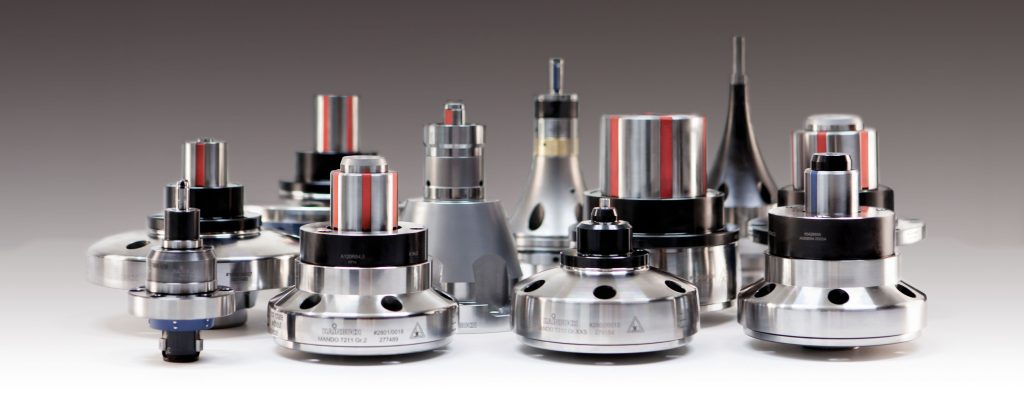
Workholding can often offer some interesting challenges for gear production, and Hainbuch has been more than up to that challenge for more than 60 years.
Hainbuch GMBH was founded by Frida and Wilhelm Hainbuch in 1951, and Hainbuch America opened its doors in 1997 when its parent company began its first sales office in Milwaukee.
Gear Production Expertise
Cutter radiuses and radial loads involved in the gear production process can be complicated, and that’s where Hainbuch’s expertise comes in.
“Hainbuch has some interesting designs to help manufacturers with these challenges,” said Michael Larson, marketing director with Hainbuch America. “As with every industry, our people are always looking for ways to understand the challenges manufacturers face and how our innovative products can meet their needs.”
A big part of that interesting design involves Hainbuch’s “Today-Tonight-Tomorrow” modular system.
“Hainbuch’s ‘Today-Tonight-Tomorrow’ modular system gives the manufacturer the ability to change from OD workholding to an ID workholding or a three-jaw chuck in less than two minutes,” Larson said. “With our centrex locating system, we have less than 5-micron repeatability from one set up to the next.”
The G-211 Mandrel

Hainbuch recently introduced the G-211, which is a mandrel specifically designed for low-volume, high-mix gear production, according to Larson.
“It is similar to our conventional turning mandrels, except it has a longer taper, allowing customers to have clearance for either their hob or their grinding wheel,” he said. “We offer sizes to accommodate clamping diameters ranging from 20 millimeters up to 120 millimeters, and it uses our standard off-the-shelf bushings and end stops. The mandrel is also designed to accommodate three separate end-stop positions. These features combine to allow manufacturers to quickly tool up jobs and to easily reconfigure the set ups between jobs.”
In addition to the G-211, Hainbuch offers a variety of both OD and ID workholding for both manual and automated production, according to Larson.

“Our ID workholding ranges from 8 millimeters to 200 millimeters, and our OD workholding ranges from 4 millimeters to 250 millimeters,” he said. “Special designs for larger parts have been custom made for businesses around the world.”
Whether it’s standard available equipment or something that needs to be custom made, Hainbuch works with customers to make sure they have a solution to fit their needs.
“We ask a lot of questions up front to understand the types of equipment the manufacturer will be using, the parts they envision running on this equipment, how frequently they expect to change over the equipment, and the tolerancing they will be expected to hold,” Larson said. “From this information, we can advise the user on workholding that will produce the quality of part they expect and provide them with the level of flexibility that allows them to meet their customer’s production requirements.”
Gear Expo
But Hainbuch continues to make strides and advancements, and plans to show off some of that at the Gear Expo conference October 24-26 in Columbus, Ohio.
“Hainbuch is introducing the MAXXOS mandrel,” Larson said. “The hexagon design of the MAXXOS provides more stability for certain applications by better withstanding radial loads on the bushing. This can allow for more aggressive machining rates and increased production.”

Hainbuch expects to demonstrate the MAXXOS mandrel at Gear Expo along with its T-213 mandrel, according to Larson.
“Our T-213 mandrel has been an industry staple for many years and is commonly used in high-production applications,” he said. “We will also have various configurations of the G-211 mandrel designed for lower-volume/higher-mix production environments.”
And since Hainbuch focuses on minimizing machine setup time, it will have examples of fast and accurate changeover devices from its “Today-Tonight-Tomorrow” system to the centroteX system.
“Our centroteX system allows the manufacturer to completely install almost any workholding device in their plant in under five minutes with repeatability in the single-digit micron range,” Larson said.

History of Innovation
Hainbuch GMBH has a long history of innovation that all started with the original quick-change collet system, first patented in the U.S. in 1980.
“This invention has now been copied many times and is the de facto industry standard,” Larson said. “Today, Hainbuch boasts over 150 patents worldwide and continues to revolutionize the field of precise, adaptable, and quick-change collet chucks.”
Fifteen years after Hainbuch America began marketing its line of modular, quick-change chucks, it moved into a 14,000-square-foot manufacturing facility in the aptly named Milwaukee suburb of Germantown.
The new plant houses Hainbuch America’s team of inside sales representatives, engineering, and manufacturing, according to Larson.
“Together with our colleagues in Marbach, Germany, Hainbuch America has the capability to assist North American customers in collaborating on special application designs, engineered workholding solutions, and the full manufacture of products designed to fit their needs,” he said.
More info hainbuchamerica.com





































